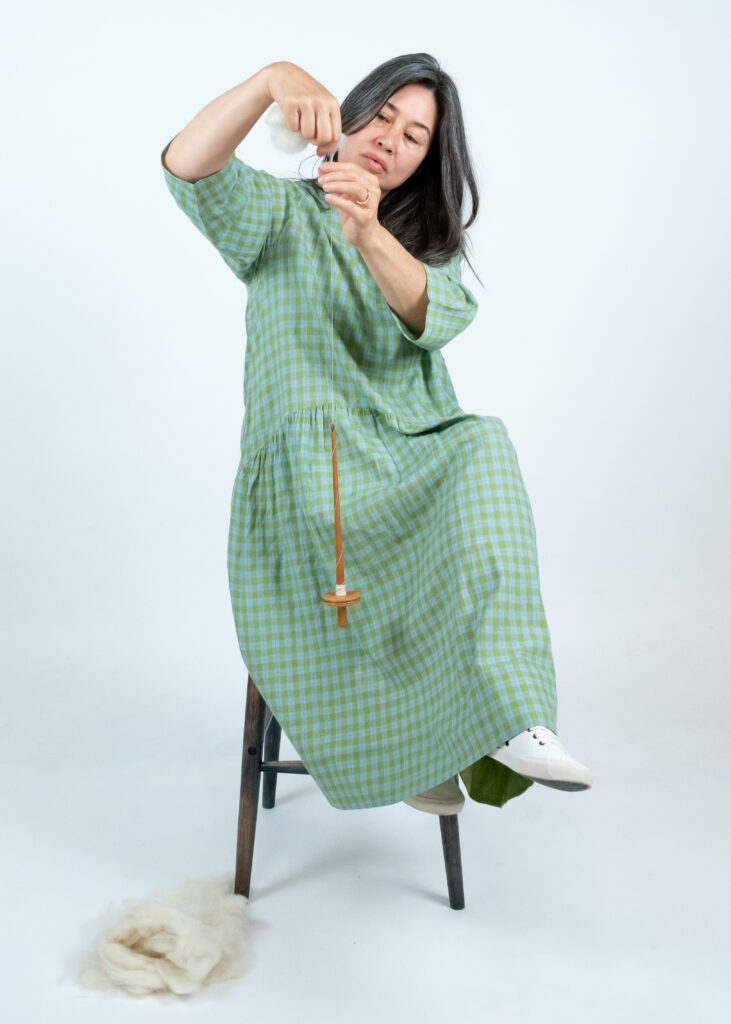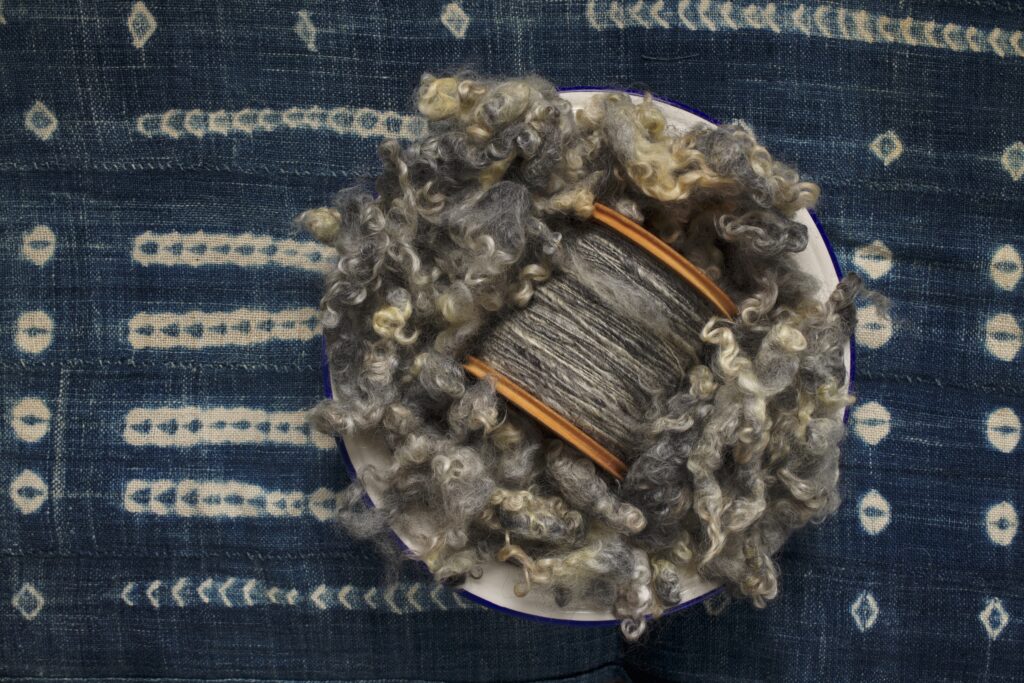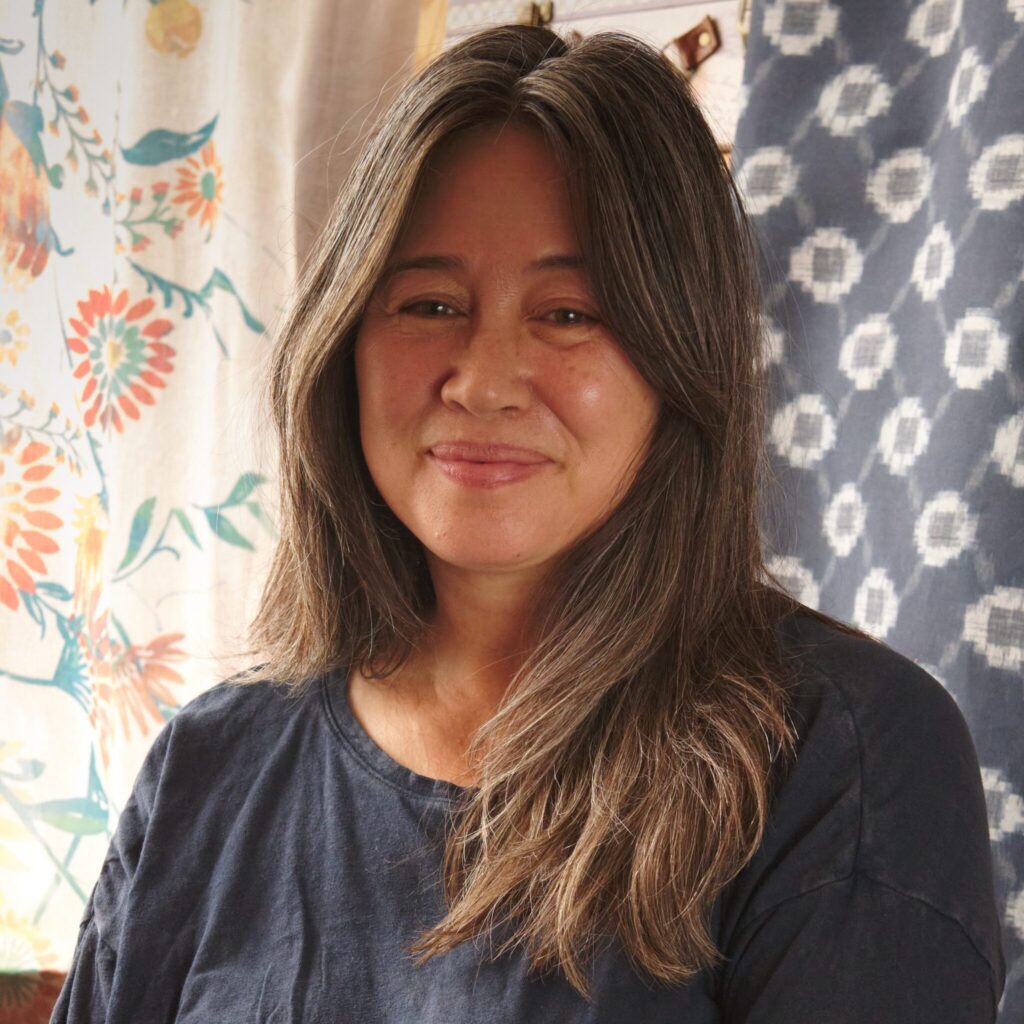
Earlier this year, in advance of her lecture on sustainability in textiles, handspun fiber artist Gigi Matthews spoke with us about her work with rare sheep fibers. The surfaces of her studio in Brooklyn are covered in fibers, animal and plant, which she spins on her wheel or using her drop spindle on the subway. On Friday, July 26th, Gigi will teach an in-person spinning workshop at the Tatter studio. Students will leave with a spindle of their own and the foundational skill for endless future projects.
We met with Gigi again to discuss the process of learning to spin: you can read our conversation and learn more about the class below.

Tell me how you learned to spin.
Let’s see, my child Jean just turned 25. So I learned it 19 years ago. As a child, Jean was hyperactive. My mom taught them how to knit and then crochet when they were six, and they instantly wanted to learn to make their own yarn. We lived in London at the time, near a city farm, and we went to a festival where they were shearing the sheep and a spinner put her spinning wheel right next to the fiber and said anybody who wants to learn to spin could come on up Jean stepped up, six years old, and learned to spin. And then Jean taught me.
There was a store in London called Handweavers Studio which was run by a California hippie who had moved to London in 1973. It was in an old Victorian house and she had all these baskets filled with rare breed sheep wool and every plant fiber you could imagine. She had flax, hemp, horsehair, camel fibers, you name it.She had one of those old scales where you put the weights on it and balance it. You would shop around with a basket, bring it to her, and she put it on the scales. It was just amazing.
As a six year old, Jean was so creative in the way kids are, just combining all these things that no regular spinner would ever think to combine and making these amazing yarns. I started loving the texture and the colors I could do and of course the wheels are fun. So Jean taught me, but of course kids grow and they lose interest in things. I kept on spinning, and because I was not in a guild and really didn’t know anybody who did fiber arts, nevermind spinning, I just kept doing these unconventional things and then started selling it at a local store in London and then on Etsy. When I came to New York, I ended up teaching.
So, in terms of hand spinning, when did you start using a drop spindle?
So the drop spindle was actually the first, because wheels are really expensive! Although Jean learned to spin on the spinning wheel at the sheep shearing festival, when we went into the shop and saw the price of wheels I decided we should start with a drop spindle. So we just got a little $10 spindle, the simplest you can possibly get, just a stick with a piece of plywood on it. We both were spinning with the spindle. Once it was clear how into it they were, Santa Claus brought Jean a spinning wheel. Nothing fancy, just the old demonstrator wheel out of the fiber store window, but I actually still use it to this day.
The thing about a spindle, though, is that is when people think of spinning, they think of spinning, but it’s actually not about the spindle or the wheel spinning. It’s actually about drafting the fibers. It’s about pulling the fibers open just to the right amount so you get the diameter of yarn that you want. So to teach spinning, if you try to teach people with a wheel they get so caught up in pedaling and the wheel turning that it’s difficult to slow down and learn to draft. If you teach them on a drop spindle, where you can get them to just work with the fiber and sit there drafting until they get a feel for it with their hands.


Is there anything else you would like your students to know?
I’ve been spinning for about two decades, but people have been spinning for 30 to 40,000 years. It is the foundation of the fiber arts: knitting, crochet, weaving, sewing, cloth itself all starts with spinning.
I’m personally really excited to spin with you, I have had a drop spindle for almost three years now but I never learned how to use it because I wanted to learn in person!
It’s hard to learn how to do a drop spindle yourself, because the technique is so physical. It requires so many tiny adjustments that a spinner will see right away if you’re teaching in person. It’s like learning to ride a bicycle by yourself. You could learn by yourself, but it’s much easier and much faster if somebody’s saying to you “okay pedal a little faster” or “steer a little straighter.” It’s exactly like learning to ride a bicycle. And once you know, you always know.

OUR LECTURER
Gigi Matthews
Gigi Matthews’ keen interest in the fiber arts is a result of decades of world travel to over 30 countries. From her native British Columbia to the souks of Aleppo and Damascus, markets in Paris to the pastures of New Zealand and Australia, she has gained a deep respect for textile traditions. An award winning spinner, her recent work focuses on sustainability, making use of reclaimed and recycled materials. Gigi has taught handspinning to guilds, at MidAtlantic Fiber Association conferences, and the John C Campbell Folk School and has published articles in Ply Magazine and Shuttle, Spindle & Dyepot. She is on the board of the Handweavers Guild of America.
